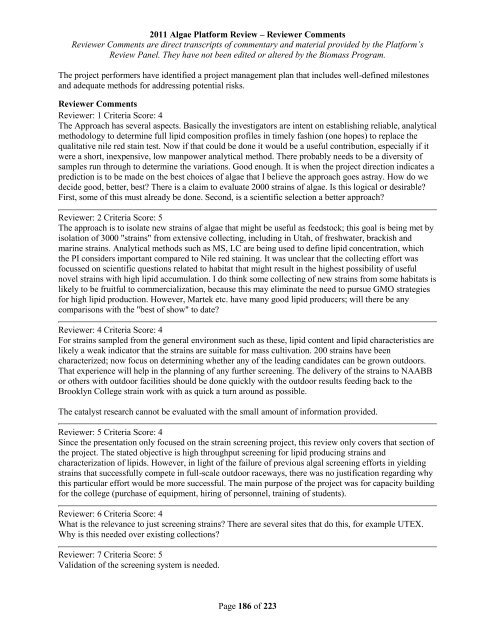Reviewer Comments - EERE
Reviewer Comments - EERE
Reviewer Comments - EERE
You also want an ePaper? Increase the reach of your titles
YUMPU automatically turns print PDFs into web optimized ePapers that Google loves.
2011 Algae Platform Review – <strong>Reviewer</strong> <strong>Comments</strong><br />
<strong>Reviewer</strong> <strong>Comments</strong> are direct transcripts of commentary and material provided by the Platform’s<br />
Review Panel. They have not been edited or altered by the Biomass Program.<br />
The project performers have identified a project management plan that includes well-defined milestones<br />
and adequate methods for addressing potential risks.<br />
<strong>Reviewer</strong> <strong>Comments</strong><br />
<strong>Reviewer</strong>: 1 Criteria Score: 4<br />
The Approach has several aspects. Basically the investigators are intent on establishing reliable, analytical<br />
methodology to determine full lipid composition profiles in timely fashion (one hopes) to replace the<br />
qualitative nile red stain test. Now if that could be done it would be a useful contribution, especially if it<br />
were a short, inexpensive, low manpower analytical method. There probably needs to be a diversity of<br />
samples run through to determine the variations. Good enough. It is when the project direction indicates a<br />
prediction is to be made on the best choices of algae that I believe the approach goes astray. How do we<br />
decide good, better, best? There is a claim to evaluate 2000 strains of algae. Is this logical or desirable?<br />
First, some of this must already be done. Second, is a scientific selection a better approach?<br />
<strong>Reviewer</strong>: 2 Criteria Score: 5<br />
The approach is to isolate new strains of algae that might be useful as feedstock; this goal is being met by<br />
isolation of 3000 "strains" from extensive collecting, including in Utah, of freshwater, brackish and<br />
marine strains. Analytical methods such as MS, LC are being used to define lipid concentration, which<br />
the PI considers important compared to Nile red staining. It was unclear that the collecting effort was<br />
focussed on scientific questions related to habitat that might result in the highest possibility of useful<br />
novel strains with high lipid accumulation. I do think some collecting of new strains from some habitats is<br />
likely to be fruitful to commercialization, because this may eliminate the need to pursue GMO strategies<br />
for high lipid production. However, Martek etc. have many good lipid producers; will there be any<br />
comparisons with the "best of show" to date?<br />
<strong>Reviewer</strong>: 4 Criteria Score: 4<br />
For strains sampled from the general environment such as these, lipid content and lipid characteristics are<br />
likely a weak indicator that the strains are suitable for mass cultivation. 200 strains have been<br />
characterized; now focus on determining whether any of the leading candidates can be grown outdoors.<br />
That experience will help in the planning of any further screening. The delivery of the strains to NAABB<br />
or others with outdoor facilities should be done quickly with the outdoor results feeding back to the<br />
Brooklyn College strain work with as quick a turn around as possible.<br />
The catalyst research cannot be evaluated with the small amount of information provided.<br />
<strong>Reviewer</strong>: 5 Criteria Score: 4<br />
Since the presentation only focused on the strain screening project, this review only covers that section of<br />
the project. The stated objective is high throughput screening for lipid producing strains and<br />
characterization of lipids. However, in light of the failure of previous algal screening efforts in yielding<br />
strains that successfully compete in full-scale outdoor raceways, there was no justification regarding why<br />
this particular effort would be more successful. The main purpose of the project was for capacity building<br />
for the college (purchase of equipment, hiring of personnel, training of students).<br />
<strong>Reviewer</strong>: 6 Criteria Score: 4<br />
What is the relevance to just screening strains? There are several sites that do this, for example UTEX.<br />
Why is this needed over existing collections?<br />
<strong>Reviewer</strong>: 7 Criteria Score: 5<br />
Validation of the screening system is needed.<br />
Page 186 of 223




